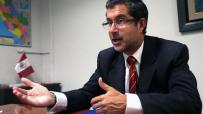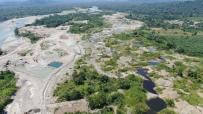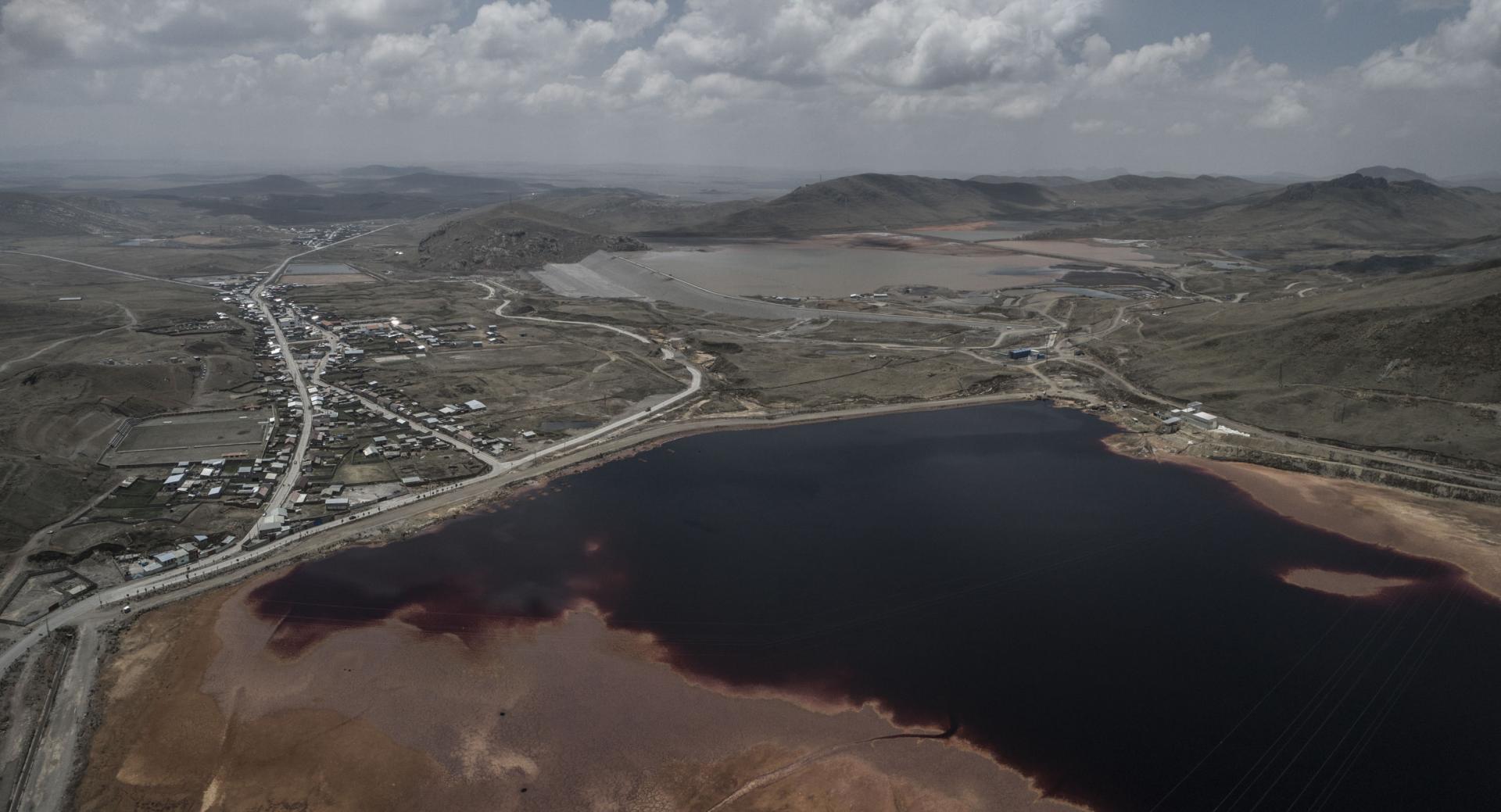
Standing in front of the greyish cement blocks, where the headquarters of the Health Social Security in Lima operate, and with a knife hidden in his clothes, Simeon Martín Huete reviewed his plan to take his life for the last time. It was late 2018, and it was four years since her daughter Esmeralda had begun bleeding from the nose repeatedly, due to severe medullary aplasia diagnosed; and two years since her first analysis showed that her blood was contaminated with lead: Esmeralda had 28 micrograms of lead for every deciliter of blood, almost three times the maximum levels permitted.
Simeon was fighting a battle before EsSalud to have her daughter receive a bone marrow transplant. In the last months of 2018, Esmeralda had worsened: platelet transfusions, which she had to receive every two days, caused her to have fever. In his despair, Simeon thought that taking away his life at the Social Security headquarters could ensure a priority attention. However, as he entered the property, Simeon decided otherwise. “My daughter wants to live,” says Esmeralda’s father, a year after that, from his home in Pasco.
Although her daughter receives medical care in Lima, Simeon and Esmeralda live in the Vista Alegre neighborhood, located in the district of Simón Bolívar, in the city of Cerro de Pasco. From their home, they can watch El Tajo, an open-pit mining operation made up of about 30 huge steps, each narrower than the previous one, as they approach the bowels of this mining city, and where you can still see the dump trucks and hear the sound they make. Ten years ago, anthropologist Barbara Trentavizi pointed out the similarity of this place to the concentric circles of Dante Alighieri's hell.
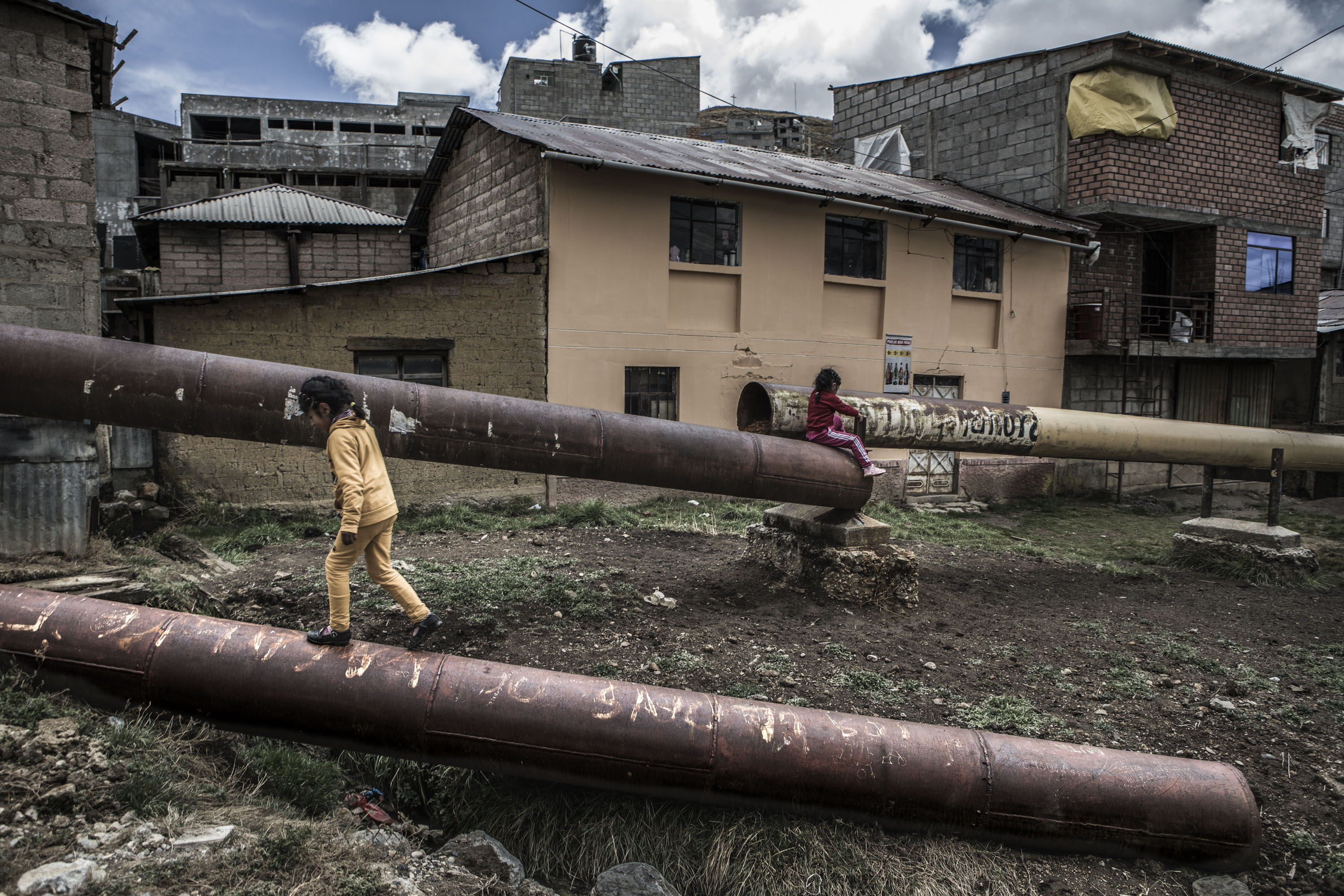
DEBRIS. At the front of these houses, on seven metal stands, rests a thick rusty and unused pipe, which was part of the gear of the Raul Rojas open pit. At the moment, these houses are uninhabited.
Photo: Marco Garro
Siméon believes that the cause of his daughter's disease is The Tajo seen from his home ─the open-pit with the official name of Raúl Rojas─ and the mining operations in Cerro de Pasco, which have been in operation at least since colonial times. However, in recent years, it is operated by Volcan, a company controlled by the Peruvian Romañana Letts family, with around 25% of the shares, and by Swiss capitals conglomerate Glencore, with more than 55% of the shares in this mining company.
Volcan purchased the Raul Rojas open pit in 1999; after it was first operated by the then U.S. capital mining company Cerro de Pasco Cooper Corporation and, later, by Empresa Minera del Centro del Perú (CENTROMIN), during the military government of Juan Velasco Alvarado. In 2010, this open-pit operation produced 1.9 million tons of ore, representing, together with Volcan's other operations in Cerro de Pasco, a total of 52 thousand tons of lead concentrate, according to its annual report.
In 2012, Volcan suspended the exploitation of the Raúl Rojas open-pit. Since then, it only processes the marginal ore of this operation. In addition to Pasco ─which accounted for 19% of its total sales in 2012, ─ Volcan also has mining operations in the Junín region. Glencore, in turn, has investments in Ancash and Cusco, through the mining companies Antamina, Antapaccay and Los Quenuales. Volcan’s sales exceeded US$754 million last year; and, in 2020, its lead exports have exceeded US$25 million.
In this context, Volcan is among the most fined companies for having committed different environmental offenses in Peru, according to the list of the Environmental Assessment and Control Agency (OEFA). In the district of Simón Bolívar alone, where Simeon and Esmeralda live, the mining company has been sanctioned 23 times, between 2010 and 2016, representing a cumulative fine of US$3 million. “Lead exposure is a major health problem for the [Cerro de Pasco] population near the mineral deposits,” says the National Center for Disease Epidemiology, Prevention, and Control.

ESMERALDA. After Simeon Martín Huete's daughter received a bone marrow transplant in Argentina, she continued living in Cerro de Pasco, near The Tajo.
Photo: Marco Garro
By the end of this month, however, sanctions against Volcan for its operations in Cerro de Pasco could start to be scrutinized by international authorities. On 29 November, Swiss citizens will define, via a referendum, whether they will amend their Constitution. If this initiative is approved, Swiss-based companies must comply with environmental standards and respect human rights when operating in foreign countries, as is the case with Glencore and its operations in Cerro de Pasco.
"Again and again, Swiss-based corporations violate human rights and ignore minimum environmental standards," claims the international organization Swissaid, and mention Glencore's mining operations in the province of Espinar, Cusco, as an example. If the so-called Corporate Responsibility Initiative is approved, families such as Simeon and Esmeralda’s will be able to claim, before the Swiss authorities, that Glencore did not respect the health of Peruvian citizens and the environment in Cerro de Pasco.
In this context, a team from OjoPúblico toured the main neighborhoods, human settlements and village centers of the district of Simón Bolívar, around the Volcan mining operation, and spoke with about ten families with children sharing Esmeralda’s characteristics: high blood lead levels, problems of growth and learning, deficiencies in short-term memory and speech, and the sign that has become characteristic among these children: nose bleeding.
The Bleeding Children
The streets of the Simón Bolívar district, where Simeon and Esmeralda live, are usually lit during the evenings, either by the yellow light of the public electricity poles, or by white of rays that announce the arrival of thunder and winter. The silence of the neighborhood, on the other hand, is interrupted only by barking stray dogs, who roam in packs in the streets of this city, located at more than 4 thousand meters of altitude.
With 12 years, and without the need to use a wheelchair, Esmeralda opens the door to her room. It will soon be two years since, finally, Simeon's daughter received a bone marrow transplant in Argentina, where she had to stay in hospital for six months, together with her parents. Although a little sleepy, Esmeralda confesses that she wants to be a doctor. “She wants to save lives,” adds Simeon.
The struggle of Esmeralda, however, has not yet ended. Earlier this year, Simeon, his wife, and daughter traveled to Lima with other families from Cerro de Pasco and camped in front of the Ministry of Health (MINSA) headquarters to demand heavy metal detox for their children. “The Argentinian doctors almost fell flat on their backs when they saw the results of my daughter’s lead blood tests,” Simeon confesses to OjoPúblico.


THE GIRL AND THE MING. In 2016, Esmeralda had almost three times the maximum levels permitted of lead on blood. She lives near the concentric circles of the open-pit mine.
Photo: Marco Garro
Near Simeon and Esmeralda’s house, in the human settlement José Carlos Mariátegui, lives Alexis, another eight-year-old boy who bleeds through the nose and has recorded high lead blood levels. “The doctors at the National Children’s Health Institute in Lima have told us that we have to leave ,” his mother, Dilma Espinoza Cristina, says standing at the door of their house, with poor public lighting, with her face illuminated with every lightning falling from the sky because of the early winter storm.
Since doctors confirmed the presence of arsenic and lead in his blood, Alexis is being treated at the Children's Health Institute in Lima, according to his mother. His last visit to the capital was in November last year: He has not been able to return due to the pandemic. In turn, his last nose bleeding occurred only three weeks ago. However, Dilma's main concern is that her child has trouble following the classes of the state's Learning at Home radio program. “When I teach him, I forget,” Dilma recognizes.
Effectively, the World Health Organization warns that lead affects children's brain development, resulting in attention problems, and reduced performance in classes, as well as causing anemia, hypertension, and kidney damage. The U.S. Center for Disease Control and Prevention adds that lead poisoning creates learning difficulties and behavior problems for children , as well as headaches and memory loss. Nose bleeding is considered a symptom of heavy metal exposure in Pasco since the beginning of the last century, and has been reported this year by the organization Source International in its latest report.
Alexis himself confesses that he does not like his classes, and his mother claims that his problems retaining short-term information are the result of the lead in her child's blood. Now, Alexis and her 15-year-old sister Mayeli share a cell phone to copy the tasks sent by their teacher via WhatsApp, while they cannot leave home due to the Covid-19. “We are spending a lot on the Internet,” says Dilma, while sitting on a table covered by a founding flag of the place where they have lived for 22 years. “My parents were founders of José Carlos Mariátegui,” she adds with pride.


CHILDREN OF LEAD. Alexis, his sister and friends live in the human settlement José Carlos Mariátegui. He bleeds through the nose and has recorded high lead blood levels.
Photo: Marco Garro
Close to Alexis's house, but in the village center of Paragsha, Wendy Castañeda lives. In 2012, while Volcan recorded millionaire sales of lead concentrate abroad, nine-year-old Wendy's blood tests showed that every deciliter of her blood contained 12 micrograms of lead, even though the U.S. Center for Disease Control and Prevention warns that lead levels in children should be below 5 micrograms. “My whole family has bled, so my goal is to get out of here as soon as possible,” says his father Marco Castañeda Gonzales.
Marco and his wife Vilma Tobalino live with Wendy and their four other children in Paragsha, a village center in Cerro de Pasco bordering Raul Rojas to the west. From his house yard, they can see the dump trucks turning around the concentric circles of the open-pit mine, and an artificial hill that has been created by the accumulation, for years, of the rock clearing of the Volcan-operated mine. This family's nightmare, according to the opinion of this married couple, began in 2018.
“Kiara is bleeding,” Wendy shouted about her younger sister, who was 12 years old in 2018. Upon entering the home, alerted by her daughter's cry, Vilma found a scene she remembers in detail: “It seemed that a bucket of blood had spilled.” The girl was taken to the nearest heath center, then transferred to the Daniel Alcides Carrión Regional Hospital and finally attended at the National Children’s Health Institute in Lima. During the months that both parents accompanied their daughter in the capital, the three older brothers ─Junior, Wendy and Marco─ left school and started to work to pay for the expenses.
“The diagnosis was chronic myeloid leukemia,” says Vilma, while holding photos showing her daughter Kiara, in black-and-white, hospitalized in the capital city. “She was as white as paper, she could not stand, and you could count her ribs,” she adds, while listening to the background of the earth moving in the bowels of the pit.

LEUKEMIA. Kiara and her siblings' blood tests showed that every deciliter of their blood contained high levels of lead. She has been diagnosed with chronic myeloid leukemia.
Photo: Marco Garro
Although Kiara is stable, Marco demands the State to comply with the commitments agreed upon with its family and others in the district of Simón Bolívar, which includes “the relocation of people affected [by mining],” according to the February 2018 minutes. For this reason, between March and June of this year, Marco and his family stayed in Lima to claim compliance with the agreements. In fact, the youngest of his daughters, Genesis, learned to walk in front of MINSA's offices in the capital.
“I dream that my children can go to college,” says Vilma, who a month ago used full roll of toilet paper to control bleeding from her own nose. Marco, in turn, is afraid that Genesis will repeat the process that Kiara went through in 2018, because she is also bleeding from her nostrils at two years old. “Our children don’t grow up, they have headaches, and the children I have seen in Paragsha bleed,” Marco says, adding that their struggle is to save Kiara’s life, who doctors expect to live some 10 to 15 years more.
The nostalgia of a lake
The impacts of mining on the environment of Cerro de Pasco are not limited to the pit. The Quiulacocha community, for example, received that name because, according to the locals, its territory was natural habitat for gulls who came to rest in the adjoining lake with the same name. ‘Quiula’ means gull in Quechua; and ‘cocha’ means lake. However, this body of water has served as a deposit of mining tailings since the 1920’s, under the operation of the Cerro de Pasco Cooper Corporation; and, since then, gulls have stopped coming.
The lake is dead now. Where blue should stand out, you can only see different shades of blood red and orange. As an example, in 2011, artist and researcher Elizabeth Lino Cornejo ─best known by the name of her performance “La Última Reyna de Cerro de Pasco─ along with anthropologist Federico Helfgott Seier and naturalist Flaviano Bianchini introduced a fish into a sample of water extracted from this tailing dam, located within the district of Simón Bolívar. In forty seconds, the animal died.
The house closest to the tailing dam is meters away. At this distance, the ten children of María de la Cruz Zacarías, who is 64 years old today, were born and played. She recalls that, when she was a small girl, she played in the crystal waters of the lagoon, where she bathed, fished and counted the gulls. Decades later, her children played in the dry tailings dam into which that lake had become. In 2006, Gian Piere, one of his children, reported 28 micrograms of lead in blood, about three times above the permitted health standards.


A FORMER LAKE. ‘Quiula’ means gull in Quechua; and ‘cocha’ means lake. However, this body of water has served as a deposit of mining tailings since the 1920’s.
Photo: Marco Garro
Maria de la Cruz, who describes herself as both father and mother of her children, has moved in front of the health center in Quiulacocha. She has lost sight in one of her eyes; and she walks with a limp for having carried her daughter Patricia Gutiérrez de la Cruz for two decades. She was born with myelomeningocele, a syndrome where the spinal cord does not develop properly. “I want to be a doctor to cure everyone,” says Patricia, 20, from her wheelchair, smiling, despite her speech disorders.
At 11 in the morning, Maria opens the gate of her house for Patty's wheelchair to go through. Maria calls her daughter Patty affectionately. As they cross the street toward the health center, one of the few gulls, still hanging around the area, flies over the streets of Quiulacocha. Patty wears a red sweater, purple pants, and a woolen hat, which covers a valve connecting her skull to her digestive system, as part of her treatment. While the medical staff attends Patty, the medical history of the Gutierrez de la Cruz family rests on the table: an orange folder labeled 062.
Children with Lead
Children in Quiulacocha affiliated with the Comprehensive Health Insurance (SIS) or who have no health insurance are attended at this medical center by a nursing technician who has been in town for 10 years, and by a doctor who serves her Rural and Urban Marginal Health Service (SERUMS). The building inside walls are covered with banners from the campaigns to fight anemia, because "a child with malnutrition has a greater risk of lead absorption," indicates the head of Pasco's Regional Health Directorate (DIRESA), Alcedo Jorges Melgarejo, in an interview with our venue. According to their official figures, between 2017 and 2019, 50 per cent of children under 36 months had anemia in Pasco.
In addition to attending an average of up to 10 people a day, this center follows up on children between the ages of 2 and 12 who have gone through a blood lead test. When they are older, the medical staff at this health center explains, lead enters the bones and thus decreases the concentration of metal in the blood system. Once they have the test results, ─processed in a laboratory in the Huariaca district for the last three years─ children are included in up to four categories.
The first include children with permitted blood lead levels, i.e. less than 10 micrograms per deciliter. The second include children who have between 10 and 19 micrograms of lead in blood. As mentioned by DIRESA Pasco's chief in an interview, 40% of the children of the region are in this category, including Patty. The medical history of the Gutierrez de la Cruz family reveals that Patricia showed a maximum of 11.6 micrograms of lead for every deciliter of her blood, while under control.
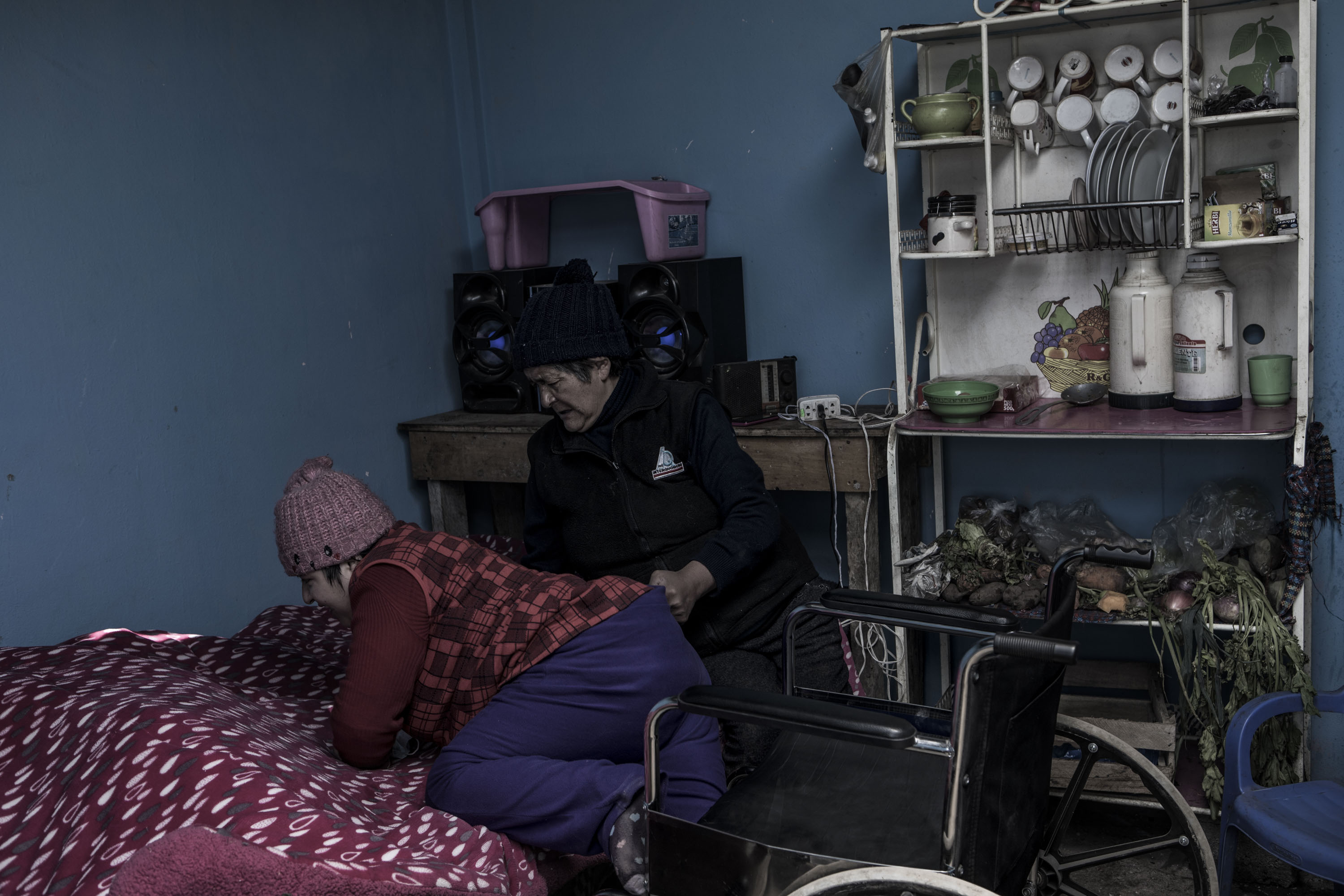
A FUTURE DOCTOR. Patricia wants to be a doctor "to cure everyone". She has shown a maximum of 11.6 micrograms of lead for every deciliter of her blood.
Photo: Marco Garro
In the third category, in turn, we find children who show between 20 and 25 micrograms of lead per deciliter of blood. This category includes, for example, five-year-old Abdiel, who also lives in Quiulacocha and attends the same medical center as Patty. “He bleeds hard through the nose,” says his 32-year-old mother, Mery, who refused to identify herself for this report. Abdiel is the second of three children and, according to his mother, he had up to 21 micrograms of lead in blood. The last time he bled from his nose was three weeks ago.
“[Mining has changed] the environmental impact [in Quiulacocha], tailings began to grow,” Mery says. Abdiel, meanwhile, is running around his dog in his house yard, and only stops to carry a black sheep that they keep in the home, while he tells us he wants to be a lawyer when he grows up. Abdiel, like other children with high blood lead levels in Quiulacocha, receives a syrup containing calcium, delivered by the health center as part of his treatment.
As she watches her two children run around in her yard, and with the third eight-month-old one in her arms, Mery admits that she is aware that staying in Quiulacocha can worsen her health. Together with her husband, they have thought about moving to Huánuco, “because they have told us that, in the long run, lead will hurt us,” but it is more difficult for them to get a stable job in that region. “We have lived here all our lives,” says Mery.
Something similar happens with the Ramos Aguilar family, who have also lived in Quiulacocha for four years. “In Huánuco there is no work,” admits Karina Aguilar Falcón, who is a native of the Huánuco but started a family with a Cerro de Pasco natural. The couple had only one son, called Teby, who this afternoon is wearing a green sweater, a gray tracksuit and a black wool hat, while dragging a toy dump truck forward and backward.

CATEGORY FOUR. In 2019, Telby's test showed 25.6 micrograms of lead in blood. Despite these levels, Telby has been able to overcome the anemia he experienced in his first years of life.
Photo: Marco Garro
In 2019, the heavy metals laboratory at the Huariaca Health Center in Pasco province processed two blood samples from Telby. The first, in April 2019, placed the young Ramos Aguilar in category four, since it showed the presence of 25.6 micrograms of lead in blood. The head of DIRESA believes that, at this level, we are already talking about intoxication. “In the health center, I was told that the land was contaminated by the mine,” Karina tells us while her son plays in the unpaved courtyard.
In December of the same year, however, a second test showed a reduction of Teby's blood lead levels to 22.2 micrograms. Karina's only son also takes the vitamin supplement and has been able to overcome the diarrhea and the anemia he experienced in his first years of life. Although, his mother says, Teby still bleeds from the nose: “He bled just four days ago.”
“We have families and children with high blood lead levels, and we have arranged with the Children's Health Institute in San Borja, in Lima, to conduct telemedicine consultations,” explains the head of the Pasco DIRESA, because the testing had to be suspended during the pandemic. The official also claims that lead pollution causes neurological problems: “we have cases of children with seizures.” Currently, according to official figures from the region, only six children are in category four.
A ghost town
In addition to pollution, mining has led to the exodus of entire families outside the Pasco region. At least two families, whose children have high blood lead levels and who were contacted for this report, excused themselves from participating, as they no longer live in this area. In the village center of Paragsha, for example, the five two- and three-story houses of Jiron Los Libertadores have been abandoned. “We have no water,” is written with white paint on the metal door of one of these homes.
The reason for the migration of these families may be found in an old mining vestige in Cerro de Pasco. At the front of these houses, on seven metal stands, rests a thick rusty and unused pipe, which was part of the gear of the Raul Rojas open pit. This tube is split in half, and one end is settled on a concrete block. In front of this structure, there is only Dominico Matias Cristobal, a seller of apples, mandarins and other fruits, who confirms that the houses are uninhabited.


GHOSTS. The mining in Cerro de Pasco has led to the exodus of entire families outside the Pasco region. The emblem of this abandonment process is the Ayapoto district.
Photo: Marco Garro
The emblem of this abandonment process is, however, the Ayapoto district. In a white temple with blue borders, with windows either broken or replaced with wood, it is hard to read in the remaining painting: Pentecostal Evangelical Church. The place is crowned by a rusty metal lamp, with no bulb. The surroundings show a similar scene: the grass has grown into the floor of abandoned houses with broken windows. Where there used to be a bakery, there are now only three solid walls, no roof, and a dog resting on the ground covered with weeds.
Among dusty and abandoned tricycles and toys, as well as remains of appliances such as televisions all scattered throughout the old streets, however, a figure is looming. “I am a true Ayapotino, and I am not leaving,” declares William Gomez Luis. Together with his wife and four daughters, they are the last family to inhabit this neighborhood. “My father, my mother, my grandparents and my great-grandparents are Ayapotinos; that is why I don’t want to leave,” adds William, standing on top of a ladder leaning against a solid wall.
‘Aya’ means dead in Quechua, says William, and ‘poto’ means coffin. According to the last Ayapotino, the neighborhood land was purchased by Volcan, and abandoned between 2018 and 2019. Before that, the streets were full of life, as were the shops, sports club and bakeries. “Little by little, everything disappeared,” William tells us. A week earlier a Volcan official visited him to encourage him to leave his land. “What are you going to do here all by yourself?” William recalls that the official asked him.
In mid-2019, at the age of 47, William felt an urgent need to preserve the memory of his native land when he heard that Ayapoto was going to disappear. Since then, William and his wife have become avid collectors of the bottles, coins and other objects they find in houses abandoned by their once neighbors. “I started to collect the history of Ayapoto,” says William, who plans to open a museum in the future.

THE LAST AYAPOTINO. Among dusty and abandoned tricycles and toys, William Gomez Luis lives with his wife and daughters. He wants to preserve the memory of his native land.
Photo: Marco Garro
One of the most interesting objects in his collection is a cardboard box, holding dozens of copies of the magazines printed by the Cerro de Pasco Cooper Corporation, which the company named El Serrano, and by the state-owned company CENTROMIN. The oldest number of his magazine collection dates from September 1951. This edition of El Serrano begins with a telegram in English, where the then president of the US mining company, Robert P. Koening, dismissed his operations manager, A. R. Merz. A 1975 edition of CENTROMIN magazine, in turn, shows in front cover, and in color, the then President Francisco Morales Bermúdez.
These magazines were delivered to mine workers living in this old neighborhood, as were William's grandfather and great-grandfather. The hobby of the last Ayapotino is to capture in drawings and paintings the memories he still has of the Ayapoto of his childhood. One of these represents the origin of the festivities of the patron saint, the Lord of Santa Catalina, through three crosses at the top of a hill; while, at the bottom, the same number of miners make their way to the depths of the mountain.
The Shepherd and the Mining Companies
On the other end of the Quiulacocha lakes, at the foot of an artificial hill made with debris from mining operations, lies the urban community of Champamarca, which also belongs to the district of Simón Bolívar in Pasco. It is 4:30 in the afternoon, and dozens of men and women, dressed in orange overalls, descend from buses, motorcycles and cars to pass through a disinfection booth located at the gates of this village center.
The workers live in Champamarca, which is directly affected by the tailings in the old lake of Quiulacocha, and the mining waste accumulated for decades in the so-called desmontonera. Both of El Tajo's liabilities are under a remediation process by the state-owned company of private law Activos Mineros SAC (AMSAC). The company trusts that both the tailing dump and the desmontonera will became Pasco's lungs .
With the support of the inhabitants of Champamarca, who are employed through the San Camilo Consortium, the state company plans to control the 78 tons of tailings that have turned Quiulacocha into an “acid water mirror”. In turn, AMSAC expects the 79 hectares of the artificial hill, created by six decades of accumulation of debris from the Raúl Rojas pit, will be the basis for the growth of a green area.
“Before these projects, at around 6 in the afternoon, it used to smell rotten,” says María Aranciaga, leader of the Vaso de Leche social program in Champamarca. After 16 years living in this village center, Aranciaga recognizes that “most children in the area have headaches and eye problems; lead is killing us slowly.” Next to her, Samanta, also affected by lead, listens attentively.
In 2011, when he was 16, Samanta ̣─who preferred not to identify himself for this report─ showed 18 micrograms of lead for every deciliter of blood. Three years later, her one-and-a-half-year-old daughter had 16 micrograms of lead. The last test taken to this family was to Samanta's sister in 2017, when she was five years old. Her younger sister then had 14 micrograms of lead, early anemia and permanent paralysis of her right thumb.


SURROUNDED. Juan Panez fed his lambs near pipes, the desmontonera and the tailing dam. He remembered the expansion of the Cerro de Pasco Cooper Corporation when he was a child.
Photo: Marco Garro
Between the desmontonera and the tailing dam, and behind Champamarca, a winding road extends. Dump trucks and 4-wheel drive trucks working at the mine closure and the area recovery circulate along it. The road is flanked by white rocks and orange water. At the front, the road is cut by a control booth, managed by a guard hired by VIP Asper, a security company. From there you can see the artificial mountain dotted by restless orange spots.
Once past the control booth, and among pipes of what used to be the mining system, Juan Panez Espinoza takes his sheep to graze, every day, at 7 in the morning. At 77 years of age and with no family besides his 60 adult sheep and 17 lambs, the shepherd still keeps the promise he made to his mother: not to sell his father's cattle, but to take care of it. “I have lived in this place since I was a child, and back then everything was flat, there was no mining debris,” Panez says as he observes a dump truck, driving along in from of his land, from his ranch.
It is 8 in the morning and Juan Panez, with a feeding bottle in his hand, is giving a combination of milk and syrup to some of his lambs, the name of sheep under one year old. “My dad used to graze the sheep over there in front; but when the tailings came in, I had to come up here,” the shepherd recalls. Juan claims, however, that the tailings and the debris from the old mining operation have made his sheep sick. They are born with pus in the lungs and the wool comes out easily. “I lost 35 lambs this year,” he adds.
In the late morning, Panez has left the gate open and the sheep run in the hill, flanked by pipes, of no use today, from the mining operation. Only the youngest of his lambs, the one born in June, has receive a name, Chica. “I was a child when the Rancas massacre occurred,” recalls the shepherd who, although he has his home in Champamarca, his grazing lands belong to Sector Five of the heroic town of Rancas.
The Rancas Resistance
One of Volcan's mining assets, which is currently operative, is the Ocroyoc tailing dam, located over 4,200 meters above sea level, in the community of Rancas, within the district of Simón Bolívar. The tailing dam began operations in the 90s, within the framework of an agreement between Rancas and its then owner, CENTROMIN. Now, through the subsidiary Empresa Administradora Cerro, this tailing dam receives the waste from the processing of oxidized minerals and the acid waters of Quiulacocha.
Rancas relationship with mining, however, dates back to the beginning of the last century, with the arrival of the Cerro de Pasco Cooper Corporation. “The gringos began to build the fence when I was a child,” recalls Juan Panez about the expansion of that mining company, and the deployment of its barbed wire, which Peruvian writer Manuel Scorza described as a worm in his best-known novel, Redoble por Rancas. “It was a nine-thread mesh,” continues the shepherd, “guarded by foremen and the Republican Guard.”
In this novel by Manuel Scorza, the personero Alfonso Rivera talks with a trader from Huanuco, who visited, every year, the community of Rancas, located today in the district of Simón Bolívar. Then, the fable based on true facts mentions to the wiring that Juan Panez watched as it grew during his childhood. “And where does [the wiring] end,” Rivera asked, to which the merchant replied: “It doesn’t end, they want to fence the world.”

THE SURVIVOR. Raul Flores is one of the survivors of the Rancas resistance. On May 2, 1960, the Rancas community members took possession of their lands in Huayllacancha.
Photo: Marco Garro
The dispute between Rancas and the Cerro de Pasco Corporation, as well as the eventual victory of the community over the wiring, which cost the lives of three comuneros, has been portrayed in Scorza's work and studied in different academic texts. One of these books, written by the Rancas natural, Juan Santiago Atencio, and whose cover displays a photograph of the burial of the three martyrs of the Rancas resistance, is preserved by Juan Panez in his ranch, among his grazing instruments.
On the morning of May 2, 1960, the Rancas community members took possession of their lands in Huayllacancha, which had been occupied by the Cerro de Pasco Cooper Corporation campsites and fenced by the barbed wire that Juan Panez watches as it grew. Hours after the land was taken, the Police Civil Guard try to evict the community members violently, and killed three martyrs of the Rancas resistance: Alfonso Rivero Rojas, who was president of the peasant community at 42 years of age; Silveria Tupino Herrera, and Teófilo Huamán Travesaño, both 47 years old.
Raul Flores Córvoda, 80, is one of the survivors of this resistance. Today he lives in a house in the center of Rancas, where he keeps a photograph of himself at 20, when he became part of history. As Raul recalls, his mission was to stand on a hill near Huayllacancha, and to blow his horn if the law enforcement forces were approaching to evict them. Around 10 in the morning, Raul alerted the community members of the arrival of the Civil Guard at the Paria ranch, adjacent to the battlefield.
Rancas central square holds the busts of the community members and heroes Alfonso, Silveria and Teófilo, who pose under a statue of Simon Bolivar, who visited this community in 1824, as part of his liberating campaign. The academy also recognizes the Rancas resistance as the initial impulse of a movement that ended in the Agrarian Reform. Sixty years from the Rancas heroic deed, and 50 years after the publication of Manuel Scorza's book, however, the impacts of mining are still found in this community.
A Possible New Beginning
Judith Rojas Trinidad, for example, accepts that she thought that her family's health would be guaranteed by living in the community of Rancas, as it is far from the Raul Rojas pit, as well as from the desmontonera surrounding Champamarca and the tailing dam in Quiulacocha. In her native land, Judith has raised four children. The oldest, Monica, has nose bleeding and constant headaches, and, although she is 12, “seems to be a five-year-old girl by her size,” Judith notes about her daughter’s stunting growth.
Monica poses next to Patricia, one year younger. Monica's head barely reaches the elbow of her partner in games and mischief. “The world is not adapted to her,” says Judith, referring to the bullying that her eldest daughter experiences at school. In fact, at distance education during the pandemic has been a temporary relief for them, this Rancas citizen confesses. “When we see some problems we think of emigrating, but the reality is that we work in the field here,” Judith says.


THE CHILDREN OF RESISTANCE. Monica, Patricia and Antony are heirs of the older citizens of Rancas, who fought against the invasion of the Cerro de Pasco Cooper Corporation, in the 1960s.
Photo: Marco Garro
The family of Kelly Cornejo Carlos, a Rancas natural, also raises cattle in the field. Before the pandemic, they lived on a ranch outside the town center of Rancas, about half an hour away on foot, and their three children attended school by bicycle. They now live in the center of the community, at a relative’s house, so that children can receive their homework through Whatsapp, as part of the “Aprendo en Casa” program.
The youngest of his children, Antony, is 11 years old and listens on his cell phone the broadcast of a virtual session of the Parents Association of his school. In 2015, Antony was tested for lead in blood, and the results showed that he had 12,7 micrograms. "He tells me that his head hurts too much, his eyes hurt too; he also bleeds from his nose," says Kelly. The last time her son bled was only a month ago.
“It is not 10 children, it is not five children, it is the whole population,” notes the mayor of the district of Simon Bolivar, Pablo Valentín Melgarejo, whose offices are in a building next to the Rancas main square. The mayor points out that, since last year, he meets with the Presidency of the Council of Ministers, to have the Peruvian State implement a prevention and treatment program for citizens with heavy metals, covering the entire district. Volcan has been invited to these meetings, but according to Valentín Melgarejo, the mining company's representatives have not attended.

FUTURE.If the Corporate Responsibility Initiative is approved, Swiss-based companies must comply with environmental standards when operating in foreign countries, as is the case with Glencore.
Photo: Marco Garro
In December 2019, however, Volcan began a sales process of all their mining assets in Cerro de Pasco to the Canadian company Cerro de Pasco Resources. Although the deadline for evaluating the transaction has already expired, in September Volcan announced that they were still negotiating with its potential buyer. Although the mining company was asked about this sales process, as well as health prevention activities in this region, there was no response until the close of this edition.
In this context, Simón Bolívar mayor has clear objectives. If Cerro de Pasco Resources purchases Volcan's assets in the city, the new company would have to negotiate with the district authority for environmental care and remediation, as well as health care for citizens within its jurisdiction. “Mining was established hundreds of years ago [...] it was irresponsible mining, because it did not measure the consequences of the impacts on the environment and the people; and today the effects are very clear,” the mayor points out.
While Volcan is still negotiating to leave Cerro de Pasco definitively, Alexis, Kiara, Wendy, Genesis, Patty, Abdiel, Teby, Monica, Patricia and Antony are waiting for the results of the referendum in Switzerland. If the amendment of their Constitution is approved, it could mean a possible new beginning for them.
 Tienes reportajes guardados
Tienes reportajes guardados








